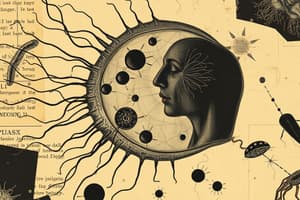Podcast
Questions and Answers
Which type of reproduction involves the union of two sexually differentiated cells?
Which type of reproduction involves the union of two sexually differentiated cells?
- Gametogony (correct)
- Budding
- Conjugation
- Schizogony
What is the causative agent of malaria?
What is the causative agent of malaria?
- Giardia intestinalis
- Trypanosoma
- Plasmodium (correct)
- Entamoeba histolytica
What is the process of multiple fission in which the nucleus undergoes multiple division?
What is the process of multiple fission in which the nucleus undergoes multiple division?
- Binary Fission
- Budding
- Schizogony (correct)
- Conjugation
What is the antiprotozoal drug that induces strand breaks in the DNA of sensitive organisms and disrupts membrane integrity?
What is the antiprotozoal drug that induces strand breaks in the DNA of sensitive organisms and disrupts membrane integrity?
Which of the following diseases is caused by Toxoplasma gondii?
Which of the following diseases is caused by Toxoplasma gondii?
What is the method of reproduction in which two protozoa meet together and exchange their genetic material?
What is the method of reproduction in which two protozoa meet together and exchange their genetic material?
What is the name of the disease caused by the protozoan Giardia intestinalis?
What is the name of the disease caused by the protozoan Giardia intestinalis?
Which of the following antiprotozoal drugs inhibits folic acid synthesis?
Which of the following antiprotozoal drugs inhibits folic acid synthesis?
Which of the following types of protozoa is non-motile?
Which of the following types of protozoa is non-motile?
What is the function of eyespots in protozoa?
What is the function of eyespots in protozoa?
Which of the following is an example of a Flagellate protozoa?
Which of the following is an example of a Flagellate protozoa?
What is the characteristic movement of Flagellates?
What is the characteristic movement of Flagellates?
What is the main locomotory organ in Sarcodina?
What is the main locomotory organ in Sarcodina?
Which of the following is a pathogenic Ciliate?
Which of the following is a pathogenic Ciliate?
What is the mode of nutrition in most protozoa?
What is the mode of nutrition in most protozoa?
What is the basis of classification of Protozoa?
What is the basis of classification of Protozoa?
What is the origin of the word 'protozoa'?
What is the origin of the word 'protozoa'?
What is the characteristic of the cytoplasm of protozoa?
What is the characteristic of the cytoplasm of protozoa?
What is the function of Ectoplasm in protozoa?
What is the function of Ectoplasm in protozoa?
What is the size range of protozoa?
What is the size range of protozoa?
What is the characteristic of freshwater protozoa?
What is the characteristic of freshwater protozoa?
What is the function of locomotive organelles in protozoa?
What is the function of locomotive organelles in protozoa?
What is the nature of most protozoa species?
What is the nature of most protozoa species?
What is the characteristic of protozoa's organelles?
What is the characteristic of protozoa's organelles?
Flashcards are hidden until you start studying
Study Notes
Protozoa
- Protozoa are unicellular (may be multicellular) eukaryotic microorganisms that constitute a large group of about 65,000 species.
- Most protozoa are harmless, free-living, and inhabit water and soil, while a few species are pathogenic, parasitic, and cause hundreds of millions of infections worldwide.
Characteristics
- Protozoa are mostly unicellular organisms with fully functional cells.
- They are chemo-hetrotrops and have locomotive organelles such as flagella and cilia for movement.
- The cytoplasm of protozoa is divided into an outer layer (ectoplasm) and an inner layer (endoplasm).
Morphology
- Protozoa resemble animal cells and contain major cell organelles, including the nucleus and mitochondria.
- The size of protozoa ranges from 3 to 300 micrometers, and a few ciliate and amoeba species are large enough to be seen with the naked eye.
- Except for sporozoates, all types of protozoa are motile through flagella, cilia, or pseudopodia.
- Protozoa have eyespots that detect changes in light.
Nutrition
- Most protozoa feed on dead plants and animal debris, while some feed on bacteria and algae.
- Parasitic protozoa feed on the fluids and tissues of their host.
- Some protozoa live in symbiotic relationships with other plants and animals.
Classification of Protozoa
- Protozoa are classified into four main types based on their motility and method of reproduction: flagellates, ciliates, sarcodina, and sporozoates.
Types of Protozoa
Flagellates
- Flagellates move using flagella, which are whip-like structures.
- Examples of flagellates include Trypanosoma, Leishmania, Giardia, and Trichomonas.
Ciliates
- Ciliates move using cilia, which are fine hair-like structures.
- Most ciliates are harmless, except for Balantidium coli, which is pathogenic and causes dysentery.
Sarcodina
- Sarcodina have pseudopodia, which are false feet, as their major loco-motor organelles.
- Examples of sarcodina include Amoeba, which can be harmless or parasitic.
Sporozoates
- Sporozoates are the only non-motile form of protozoa.
- Examples of sporozoates include Plasmodium, which causes malaria.
Reproduction in Protozoa
- Protozoa can reproduce using both sexual and asexual methods.
- Asexual methods include budding, binary fission, and schizogony (multiple fission).
- Sexual methods include conjugation and gametogony.
Diseases Caused by Protozoa
- Examples of diseases caused by protozoa include malaria (Plasmodium), giardiasis (Giardia intestinalis), amoebic dysentery (Entamoeba histolytica), toxoplasmosis (Toxoplasma gondii), and leishmaniasis (Leishmania).
Antiprotozoal Drugs
- Examples of antiprotozoal drugs include chloroquine, mefloquine, and pyrimethamine, which are used to treat malaria.
- Metronidazole is an antiprotozoal drug that induces strand breaks in DNA and disrupts membrane integrity.
- Other antiprotozoal agents include sulphonamides and trimethoprim, which inhibit folic acid synthesis.
Studying That Suits You
Use AI to generate personalized quizzes and flashcards to suit your learning preferences.



